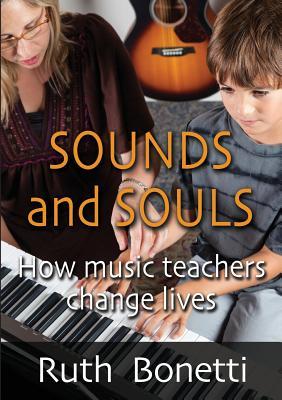Sounds and Souls: How music teachers change lives
By Ruth Bonetti
Published by Words and Music, The Gap, 2013
ISBN 9780957886186
This is the ninth book from Australian-based author and music teacher, Ruth Bonetti. Bringing a wealth of knowledge, years of experience and up-to-date information about the art of teaching (particularly as it pertains to studio teaching), Bonetti presents here a very readable guide that is easy to read, chatty, filled with wonderful anecdotes, and yet infused with reliable authority. Her self-deprecating manner, at times, makes the reader ascend easily into her world, almost as a participant, rather than an observer.
 Broken into three major sections, Part 1 (Teacher), Part 2 (Teacher-Student) and Part 3 (Teacher-Parent), the information is very comprehensive, shedding light on such aspects as Running a Business, First lessons, Methodology, Repertoire, Copyright, Practice Expectations, Motivation, Child Development, Group Teaching, Examinations, Anxiety, Communication, Relaxation, Special Needs, and Gifted Students to name just a few.
Broken into three major sections, Part 1 (Teacher), Part 2 (Teacher-Student) and Part 3 (Teacher-Parent), the information is very comprehensive, shedding light on such aspects as Running a Business, First lessons, Methodology, Repertoire, Copyright, Practice Expectations, Motivation, Child Development, Group Teaching, Examinations, Anxiety, Communication, Relaxation, Special Needs, and Gifted Students to name just a few.
There are specific chapters dealing with issues, such as repairing rhythm problems, note-reading, technique, and working with accompanists.
Lots of quotes and references are found from a wide array of legendary people, both from the past and present, such as Claudio Arrau, David Helfgott, Gerald Moore, and even Bette Midler.
Arrau’s reminiscences on being a child prodigy and its effect upon his crucial adolescent years are revelatory. Similarly, David Helfgott’s background as seen through the film, Shine, is worth noting.
Pamela Page recounts the difficult decisions she and husband Max Olding made over their son, Dene’s pathway to study in the USA. Anna Goldsworthy’s relationship with her teacher Eleonora Sivan is noted, with reference to her inspiring memoir, Piano Lessons. Rita Crews OAM outlines needs for teachers to be better trained and qualified, in order that studio teachers may be elevated from hobby status to real educators.
In regard to methodologies and whole teaching systems, there is a concise mention of Suzuki, El Sistema, and Kodaly.
The chapter, Positive Parent Relations is wonderfully sprinkled with delightful descriptions, marking parents as zealous, pushy, proud, high-flyer, low-flyer, helicopter, overcommitted and Philistine parents, all useful for the teacher to know with whom they might be dealing. Of course, generalisations can be harmful, but this is where true intelligence and knowledge of your students and their families is necessary.
This book should be added to recommended reading lists for aspiring teachers. If you have an advanced student looking at studio teaching, maybe this would be a great gift. Since instrumental and vocal pedagogies are rarely taught now at the tertiary level, books such as this, fill vital gaps. As well, Bonetti’s bibliography provides starting points for much further research into the profession of studio music teaching.
